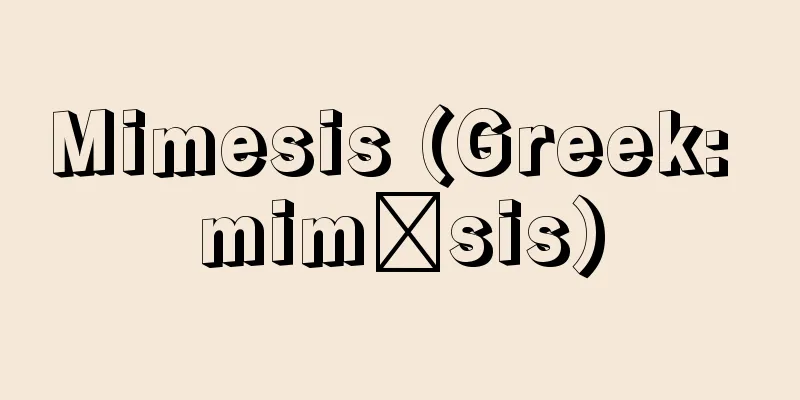Mimesis (Greek: mimēsis)

|
The word derives from the verb miméomai, meaning "to imitate" or "to make like," and basically means imitation or representational presentation. It has the same meaning as homoiōsis. The comic poet Aristophanes uses this word to refer to a person imitating the appearance of another person (The Frogs) and to a poet imitating a character he is trying to create in a poem (A Feminine Festival). However, the problematic nature of this word lies in its relationship to the diversity of the imitating subject and its object, the ontological phase of the object, and the essence of poiesis (creation). Democritus is said to have said that humans "were disciples of animals in the most essential things: of the spider in weaving and sewing, of the swallow in house-building, of the sweet-voiced swan and nightingale in song, in the way of mimesis" (Fragments). In the history of thought, the idea of imitating nature (physis) probably dates back to before Democritus. This is supported by Aristotle's words in the apocryphal Cosmology, "technologies such as portraiture, music, and grammar also seem to create this (harmony) by imitating nature," and by Hippocrates' words, "The techniques used by man resemble his natural essence (physis)" (De victu). Democritus also said, "Man should be good, or should imitate good men" (Fragments), showing that mimesis is used in the sense of imitation of values, not just form or structure. The ideas of imitation of nature and imitation of values are integrated in Plato's metaphysics. Human existence is in a tense relationship with God who watches over it, and its goal is to "resemble as much as possible God (homoiosis)" (Theaetetus), which stands at the height of goodness and beauty. God and man are connected by the golden thread of reason (Laws), and man is essentially similar to God in his inherent existence of possessing logos. However, man, who is far removed from God by various doxa (thoughts) and pathema (emotions), must seek his own original nature (physis) that conforms to God and imitate God through the practice of philosophy, which loves knowledge and seeks goodness and beauty (Phaedrus). Therefore, in the path of philosophy, knowing oneself and imitating God are essentially the same thing, and all human activity, including poiesis, is fundamentally mimesis. Therefore, when it is said that "poets are inferior creators compared to the Muses" (Laws), there is an analogy between the great creation (poiesis) that produces the work called the universe (cosmos) and the small creation of man who creates works as small necessity while imitating the gods, taking the necessity of the microcosm as his model. When human poiesis, as represented by literary creation, deviates from the original path of mimesis and attempts to mimetically reproduce individual phenomena simply "according to their appearance," that is, when it performs the most straightforward imitation of nature or things, the poet (poietes), for example, degenerates into a mere "imitator of images (mimetes)" (The Republic). For the resulting work (poiema) to be an imitation (mimema) of God's work, an analogy of the cause of poiesis in the creative subject must be established. Plato's metaphysical epistemological requirements for the causality of the subject are extremely strict, so that imitating God and reaching the pinnacle of goodness and beauty becomes an eternal task for humans, and poiesis as the mimesis of truth (aletheia) becomes extremely difficult in reality, and poiesis ends up being merely a fiction (pseudus). For Aristotle, poiesis is also mimesis, and the poiesis of tragedy is "mimesis of life and action" (Poetics), and unlike historical writing, it speaks of "what can happen" and "the universal (way of life)" (ibid.), so mimesis is no longer simply an imitation of real events. However, while he criticizes Plato's mimesis from the standpoint of metaphysical epistemology, saying that it is in fact far from the truth in terms of what and how it is spoken, Aristotle emphasizes the persuasiveness of the possible world (Heuer an genot) that Plato was wary of, and the real effects it has on the receiver (surprise and catharsis), and accepts the existence of a work as mimema within the range of probability as a subjective truth. In this way, the idea of mimesis was metaphysically examined by Plato, acquired a practical meaning by Aristotle, and exerted various influences on later generations (for example, the "imitation of beautiful nature" in 18th century French aesthetics). Even today, when we have experienced the idea of expression as an antithesis to mimetic reproduction and abstract art, the idea of mimesis continues to play an important role as the idea of enjoyment as creation or re-experiencing, or as a principle for classifying art. [Kazumi Fujita] "Mimesis: Representation of Reality in European Literature, Vol. 1 and 2, by E. Auerbach, translated by Shinoda Kazushi and Kawamura Jiro (1967, Chikuma Shobo) " "Mimesis and Poiesis, by Fujita Kazumi (included in "New Iwanami Lectures on Philosophy 13: Transcendence and Creation", 1986, Iwanami Shoten)" " W. Tatarkiewicz History of Aesthetics, I (1970, Mouton-PWN, Warszawa)" [References] | |Source: Shogakukan Encyclopedia Nipponica About Encyclopedia Nipponica Information | Legend |
|
「まねる」「似せる」を意味する動詞miméomaiに由来する語で、基本的に模倣ないし再現的呈示を意味する。同義語としてホモイオーシスhomoiōsisがある。喜劇詩人アリストファネスはこの語を、人が他人の姿をまねる場合(『蛙』)と、詩人が詩作において自らがつくりだそうとする役柄をまねる場合(『女だけの祭』)に用いているが、この語の問題性は、まねる主体とその対象の多様性、対象の存在論的位相、そしてポイエーシス(創(つく)ること)の本質とのかかわりにある。 デモクリトスは、人間は「もっとも肝要なことにおいて(動物の)弟子であった。織ったり縫ったりすることについては蜘蛛(くも)の、家造りについては燕(つばめ)の、歌においては甘い声の白鳥やナイチンゲールの、ミメーシスという仕方における(弟子であった)」といったとされている(『断片』)。思想史上、このような自然physisの模倣という思想はおそらくデモクリトス以前にさかのぼる。肖像画や音楽、文法といった「技術téchnēもまた自然を模倣してこのこと(調和)を創りだすように思われる」というアリストテレス偽書『宇宙論』のことばや、ヒポクラテスの「人間が用いている技術は人の自然的な本質physisに似ている」(De victu)ということばがそれを裏書きする。デモクリトスはまた一方で「人は善くあるべきである、もしくは善き人を模倣すべきである」(『断片』)とも語っており、ミメーシスが形式や構造のそれにとどまらず価値的なるものの模倣という意味で用いられることを示している。 自然の模倣と価値的なるものの模倣という思想は、プラトンの形而上(けいじじょう)学において統合される。人間的実存はそれを見守る神との緊張関係にたち、その目的は善美の極にたつ「神に能(あと)う限り似ること(ホモイオーシス)」(『テアイテトス』)にある。神と人とは理性という黄金の糸で結ばれており(『法律』)、ロゴスを有するという固有のあり方において人は本来的に神に似ている。しかし、多様なドクサ(思い)とパテーマ(情動)によって神と遠く隔たっている人間は、知を愛し善や美を求める哲学の営みによって、神にかなう自己の本来の性(フュシス)を探し神に倣ってゆかねばならない(『パイドロス』)。それゆえ、哲学の道において自己自身を知ることと神に倣うことは本来同じことであり、人間的活動のいっさいは無論ポイエーシスも含めて根本的にミメーシスである。したがって、「詩人はムーサの神々に比べれば劣った創造者である」(『法律』)といわれるとき、ここには宇宙(コスモス)という作品を創りだす大いなる創造(ポイエーシス)と小宇宙の必然性を範型として神に倣いつつ小さな必然としての作品を創りだす人の小さな創造のアナロギア(類比)がある。 文芸創作を代表とする人間的なポイエーシスがミメーシスの本来の道より逸脱し、個々の現象をただ「その現れに即して」模倣的に再現しようとするとき、すなわちもっとも平板な意味における自然や事物の模倣を遂行するとき、たとえば詩人(ポイエーテース)は単なる「影像の模倣者(ミメーテース)」に堕落することになる(『国家』)。結果としての作品(ポイエーマ)が神の作品の模倣(ミメーマ)となるためには、創造主体におけるポイエーシスの原因の類比が成立していなくてはならない。主体の原因性についてのプラトンの形而上学的認識論的要求はきわめて厳格であるから、神に倣って善美の極に到達することは人間にとっての永遠の課題となり、真理(アレーテイア)のミメーシスとしてのポイエーシスは事実上きわめて困難となって、ポイエーシスは、事実上単なる虚構(プセウドス)に終始してしまうことになる。 アリストテレスにおいても、ポイエーシスはミメーシスであり、悲劇のポイエーシスは「人生と行為のミメーシス」(『詩学』)として、歴史記述とは異なって、「起こりうること」「普遍的な(生の)ありよう」を語る(同書)ことから、ミメーシスはもはや単なる現実的事象の模倣ではない。しかし彼は、プラトンがミメーシスを、何をいかに語るかという点において事実上真理より遠ざかるとして、形而上学的認識論の立場から批判するのに対して、プラトンが警戒した語り出された可能的世界(ホイアー・アン・ゲノイト)の説得力、受け手に与える現実的効果(驚きやカタルシス)を重視し、ミメーマとしての作品の存在を主観的真理としての蓋然(がいぜん)性の範囲で許容している。 このようにしてミメーシスの理念はプラトンによって形而上学的に吟味され、アリストテレスによって現実的意味を獲得して後世にさまざまの影響を与えていった(たとえば18世紀フランス美学における「美しい自然の模倣」)。模倣的再現に対するアンチテーゼとしての表現の理念や抽象的な芸術を経験した今日においても、ミメーシスの思想は創作や追体験としての享受の理念あるいは芸術の分類の原理として重要な役割を担っている。 [藤田一美] 『E・アウエルバッハ著、篠田一士・川村二郎訳『ミメーシス――ヨーロッパ文学における現実描写』上下(1967・筑摩書房)』▽『藤田一美著『ミメーシスとポイエーシス』(『新岩波講座 哲学13 超越と創造』所収・1986・岩波書店)』▽『W.TatarkiewiczHistory of Aesthetics, I(1970, Mouton‐PWN, Warszawa)』 [参照項目] | |出典 小学館 日本大百科全書(ニッポニカ)日本大百科全書(ニッポニカ)について 情報 | 凡例 |
<<: Taste blindness - Mimou (English spelling)
Recommend
International Convention on the Elimination of All Forms of Racial Discrimination
Its official name is the International Convention...
Chelatometric titration - Kire to Teitei (English spelling)
When a metal ion is surrounded by a polydentate l...
Zashiki Warashi
A legendary monster. A child with a red face and f...
Hanayagi school
A school of Japanese dance. Its headmaster's ...
Glyptothek
...The Pinakothek in the Vatican Museums and the ...
Aksiba - Aksiba
It is a deciduous shrub of the genus Vaccinium in...
Albrecht, Mikhail P.
1821-? Russian doctor. In 1858, he came to Japan ...
Akita Ujaku
Playwright and children's story writer. Born ...
Johann Ludwig von Neumann
1903‐57 Hungarian-born mathematician. Born in Buda...
Clarifier (English spelling)
Also called a clarifier. A chemical device used fo...
Company Law - Kaishaho
The Significance of the Companies Act Law as a ru...
Main Meridian
… [Regular astigmatism] In the case of regular as...
Cup Noodles
A brand of instant ramen sold by Nissin Food Produ...
Weir (English spelling)
A general term for structures that cross open wate...
Aizu Otsukayama Kofun
A keyhole-shaped tumulus located in Otsukayama, I...









